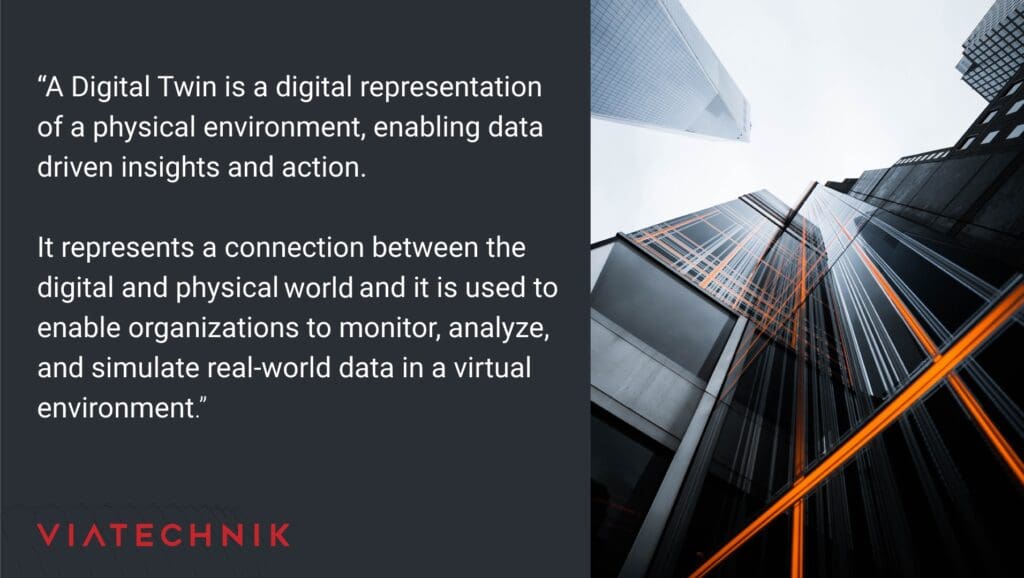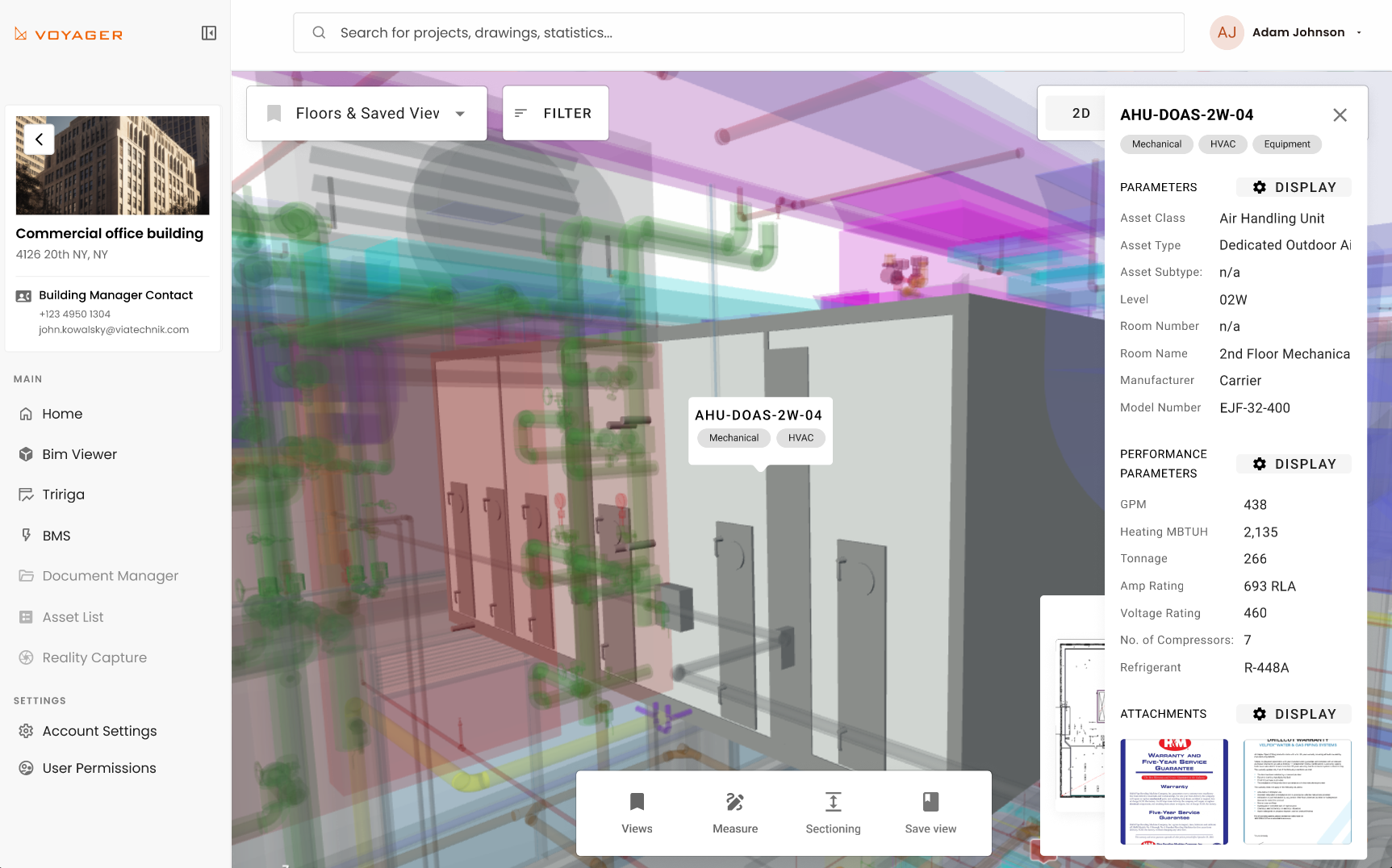
Unlocking the power of digital twins: Maximizing success with OKRs
Originally published in VIATechnik’s The EDGE on BD+C
Here are six ways we can apply OKRs (objectives and key results) to help owners effectively achieve outcomes through digital twin initiatives. Stakeholders should embrace the goal-aligning power of OKRs when considering the use of digital twins on their projects. The combination of both can lead to highly successful outcomes
In the fast-paced world of digital transformation, organizations from all industries are embracing innovative technologies to revolutionize their operations. One such technology that has gained significant traction is the concept of digital twins.
How OKRs can maximize the success of Digital Twin technology implementation
A digital twin is a digital representation of a physical environment, enabling data-driven insights and action. It represents a connection between the digital and physical world, and it is used to enable organizations to monitor, analyze, and simulate real-world data in a virtual environment. By harnessing the power of digital twins, owners can unlock numerous benefits and streamline their operations. To effectively capitalize on this technology, owners can align their efforts using Objectives and Key Results (OKRs). This article explores the advantages of digital twins and outlines six key OKRs that drive success in this digital journey.
Understanding Digital Twins
Digital twins serve as virtual counterparts, replicating the characteristics, behavior, and performance of physical assets or processes in real-time. By integrating data from sensors, IoT devices, and other sources, digital twins provide a comprehensive understanding of the asset’s current state, enabling proactive decision-making. They empower owners to monitor asset performance, simulate scenarios, optimize operations, and predict maintenance needs accurately.

The Power of OKRs
OKRs serve as a powerful goal-setting framework, aligning efforts toward strategic objectives. OKRs consist of ambitious objectives and measurable key results that provide clarity, focus, and a basis for tracking progress.
OKRs are credited back to John Doerr, a Silicon Valley venture capitalist, who first implemented OKRs during his time at Intel. Doerr then took the OKR methodology with him when he joined venture capital firm, Kleiner Perkins. From there, he introduced OKRs to more than a dozen successful portfolio companies, including Google, where it continues to play a significant role in exceptional performance, helping align and unite the company’s employees.
OKRs are designed to accomplish a common objective in fast growth and large-scale organizations. They create alignment and engagement around measurable goals, helping companies and teams move in the same direction quickly and effectively. The key is to establish an objective (the ‘What’) and then define the key results (the ‘How’).
When you analyze how the design, construction, and operations of buildings and infrastructure come together, you can’t help but see the similarity to large scale organizations, often worth billions of dollars. This sector has an exciting opportunity to adopt OKRs as a powerful tool to ensure alignment towards improved outcomes.
So, let’s consider how we can apply OKRs to help owners effectively achieve outcomes through digital twin initiatives.
1. Enhancing Project Team Collaboration
Objective:
Foster collaboration among project teams to enhance efficiency and project outcomes.
Key Results:
- Increase the adoption of collaborative tools by X%.
- Conduct regular cross-functional meetings.
- Promote knowledge sharing through a lesson learned repository.
Benefits:
Collaboration offers benefits in decision-making, project efficiency, and innovation. It harnesses collective expertise, enabling faster and informed decisions. It reduces communication gaps, minimizing delays and optimizing resource allocation. Collaboration fosters innovation through idea-sharing and creative problem-solving. These benefits lead to improved decision-making, project efficiency, and successful project outcomes.
2. Establishing Data Standards alongside Design and Construction Guidelines
Objective:
Establish standardized data protocols to ensure smooth integration and interoperability of data across various sources.
Key Results:
- Develop and implement data standardization guidelines.
- Provide stakeholders with training on data management best practices.
- Incorporate data standards within existing design and construction frameworks.
Benefits:
Data integrity and reliability are enhanced through consistent data standards that minimize errors, discrepancies, and inconsistencies. Standardized data formats and protocols enable seamless data integration from multiple sources, facilitating comprehensive analysis and asset management. Efficient data management streamlines processes, reduces manual data manipulation efforts, and enables data-driven decision-making, resulting in improved operational efficiency.
3. Improving Interoperability between Construction and Operation Teams
Objective:
Improve communication and data sharing between construction and building operations teams to eliminate unnecessary waste commonly encountered during construction handovers.
Key Results:
- Implement integrated project management software.
- Provide operations a seat at the table during design and construction.
- Leverage digital twin data for operation planning and maintenance.
Benefits:
Efficient communication and data sharing enable smoother transitions from construction to operation, enhance operational coordination, and facilitate proactive maintenance and optimized operations. Improved communication minimizes handover challenges, aligns goals, and promotes seamless knowledge transfer. Leveraging digital twin insights allows for proactive decision-making, early maintenance detection, and optimization opportunities.
4. Streamlining Project Handover Processes
Objective:
Streamline project handover processes to ensure a seamless transition from construction to operation.
Key Results:
- Define clear handover requirements and timelines.
- Create a standardized handover process and checklist.
- Reduce handover delays by X%.
Benefits:
Efficient project handover ensures smooth transitions, enhances operational readiness, and improves stakeholder satisfaction. Streamlined processes minimize delays, facilitating a seamless transfer of responsibilities. Clear requirements and standardized checklists enable thorough preparation, ensuring all necesary resources and documentation are in place. As a result, operational downtime is reduced, and stakeholders are satisfied with timely delivery and operational readiness.
5. Optimizing Operational Efficiency
Objective:
Enhance operational efficiency and minimize downtime through digital twin insights.
Key Results:
- Identify and implement optimization opportunities based on digital twin simulations.
- Reduce maintenance and energy costs by X%.
- Increase asset utilization rates.
Benefits:
Utilizing digital twin insights offers advantages like cost savings, reduced downtime, and improved resource allocation. It optimizes operational efficiency, leading to significant cost savings over time. Proactive maintenance planning minimizes unplanned downtime, enhancing asset reliability and operational continuity. Leveraging digital twin insights enables optimized resource allocation, reducing waste and improving overall operational efficiency.
6. Leveraging IoT for Smart Buildings and Portfolios
Objective:
Implement IoT and digital twin technologies to develop intelligent buildings and portfolios that enable real-time decision-making for building performance.
Key Results:
- Integrate IoT devices with digital twins.
- Establish real-time monitoring systems.
- Enable remote control and predictive maintenance.
Benefits:
IoT integration with digital twins brings benefits such as enhanced building performance, predictive maintenance, and centralized portfolio management. It optimizes operations, improves occupant comfort, and reduces energy waste. Remote monitoring and predictive maintenance based on digital twin insights minimize equipment failure and extend asset lifespan. Centralized monitoring and data-driven decision-making across multiple assets enhance operational efficiency.

Why Stakeholders must unlock the potential Digital Twins and OKRs offer
Digital twins offer immense potential for owners to optimize their operations, foster collaboration, and drive innovation. But achieving success with digital twins is no small undertaking. Building design, construction, and operations processes are inherently complex, and a myriad stakeholders must mobilize toward a common objective. By leveraging the capabilities of digital twins and aligning efforts through OKRs, owners can unlock a range of benefits, from improved project outcomes to streamlined operations and cost savings. Embracing digital twins and establishing clear OKRs will propel owners into a new era of digital transformation, where data-driven insights and virtual replicas pave the path to success in the physical world.



